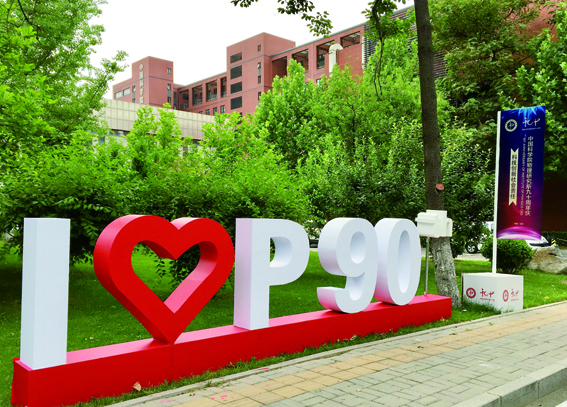
The Institute of Physics, Chinese Academy of Sciences celebrates its 90th anniversary on June 8, 2018 in Beijing. (Photo: XIN Ling)
The Institute of Physics (IOP), Chinese Academy of Sciences celebrated its 90th birthday in June 2018 with hundreds of staff researchers, alumni and international collaborators. By organizing a symposium on the 8th and a forum on the 9th, IOP aimed to “honor the past and look into the future.”
IOP is one of the oldest, biggest and most prestigious research institutes under the Chinese Academy of Sciences. Its origin can be dated back to 1928, when the National Research Institute of Physics, Academia Sinica was established. In 1950, by merging the National Research Institute of Physics, Academia Sinica and the Institute of Physics, National Academy of Peiping (established in 1929), a new institute was founded as the Institute of Applied Physics, Chinese Academy of Sciences. Eight years later, it adopted the current name of IOP.
IOP has made essential contributions to the founding of modern physics in China, though it started with a very limited number of researchers who worked on a small range of research subjects. Today, it is a large-scale research institution with an extensive and multidisciplinary scope. The research fields at IOP now range from condensed matter physics to optical physics, atomic and molecular physics, plasma physics, and theoretical and computational physics. IOP is also hosting the National Center for Condensed Matter Physics Research with funding from the Ministry of Science and Technology of China.
Over the years, IOP researchers have filled in many gaps in the development of modern physics in China. They developed the country’s first hydrogen and helium liquefiers, synthesized the first artificial diamond, and built the first ruby laser in China. Research outcomes with international impact include the discovery of copper and iron based high-temperature superconductors, topological insulators, the quantum anomalous Hall effect, and Weyl semimetals, among many others. Meanwhile, the institute has developed high-tech products such as high quality neodymium permanent magnets, lithium-ion batteries, single-crystal silicon carbide substrates, and high-temperature superconductivity filters which have hit both domestic and global markets.
Ward Plummer, a condensed matter physicist from the Louisiana State University and winner of the 2016 CAS Award for International Scientific Cooperation, was also present at the symposium. “We are here celebrating the 90th anniversary of the Institute of Physics, which is only a decade longer than my journey from a small fishing village on the coast of Oregon, around the United States to my home away from home—IOP,” he said.
LU Yu joined IOP about 60 years ago. Back then, “modern condensed matter physics was almost non-existent in China,” he recalled. However, during the past 40 years, especially since the beginning of the 21st century, the situation has dramatically changed. “A number of outstanding young scientists from China, with cutting-edge research output, emerged on the world arena. The transition from total isolation to close international exchange and collaboration is a key factor contributing to this success,” he said.
Plummer said he was very impressed. “It is inconceivable that anyone in 1928 could have imagined that in 2018 the Institute of Physics would be an internationally recognized center for research and development in material science. The future of IOP is even more exciting than the past, with the development of the Huairou Science City and the IOP generated Materials Genome and Clean Energy Platforms at Huairou,” Plummer told BCAS.

